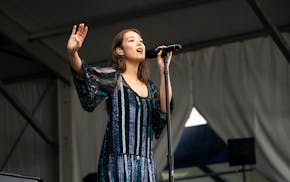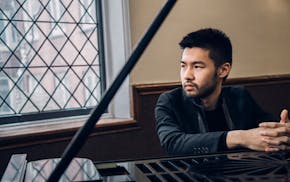If watching the Olympics hasn't provided you with enough encouragement to book a flight to Paris, a weekend Orchestra Hall visit could seal the deal.
To close the four weeks of "Summer at Orchestra Hall," the Minnesota Orchestra spent Friday evening delivering the ultimate cinematic love letter to the city — the 1951 musical, "An American in Paris" — with the music of George Gershwin coming courtesy of conductor Sarah Hicks and the orchestra.
While it might not be on the ambitious scale of the operas that used to close the orchestra's "Sommerfest" seasons, it was a grand showcase for the ensemble's versatility. For Gershwin was that rare composer who was as much a jazz-flavored songsmith as a creator of long-form works for the classical concert hall. And the score to "An American in Paris" asks an orchestra to turn on a dime from evocative impressionism à la Claude Debussy to a swinging big band of the Duke Ellington school.
Hicks and the orchestra navigated all of those shifts with aplomb, first demonstrating this expertise on a set of variations built around the ballad, "Embraceable You," while Leslie Caron danced around in five separate personas on screen. Soon, the film's principal characters were off to a jazz club, where saxophonist Benny Carter serenaded dancers from onstage. The orchestra soon took the relay baton from him, swinging its way through "Love is Here to Stay," a crew of five saxophonists making the club ambience palpable at the back of the balcony.
Other impressive work from the musicians included a sweet solo from pianist Eric McEnaney on "Tra-La-La (This Time It's Really Love)" and an interpretation both smooth and swoon-ready of "Love Is Here to Stay" as Gene Kelly and Caron danced beside the Seine, concluding with a beautiful solo from violinist Alan Snow.
It proved the ideal way to experience Vincente Minnelli's 1951 film, which is widely regarded as among the masterpieces of Hollywood musicals. Sure, the story is thin — an American artist pursues a young French woman who has captured his fancy while an American heiress pursues him — but the songs and dance sequences are splendid.
The orchestra's way with Gershwin shone through at the quietest moments — a melancholy English horn solo from Marni J. Hougham accompanying Caron's sad riverside farewell to Kelly — and in the boisterous fortissimo final strains of Gershwin's Piano Concerto in F. The latter featured Oscar Levant daydreaming his way through being not only soloist on the piece, but conductor and multiple musicians, the orchestra's percussionists in perfect sync with each strike of a gong or timpani.
The ensemble's skill with executing rapid stylistic shifts was never more impressive than when swinging up songs like "I Got Rhythm" at a raucous party, then launching into one of the composer's greatest orchestral achievements, the 17-minute ballet that provides the film's climax.
This is an orchestra that clearly gets that Gershwin was expert in the jazz and classical idioms, and there was no more delicious combination of the two than trumpeter Manny Laureano's sizzling solo on a sultry choreographed love scene between Kelly and Caron during the ballet.
While accompanying films has become a staple of Minnesota Orchestra programming, this presentation stands out as its quintessential combination of the art forms.
Rob Hubbard is a Twin Cities classical music writer. Reach him at wordhub@yahoo.com.
Minnesota Orchestra
What: "A Symphonic Night at the Movies: An American in Paris"
When: 7 p.m. Sat.
Where: Orchestra Hall, 1111 Nicollet Mall, Mpls.
Tickets: $45-$95, available at 612-371-5656 or minnesotaorchestra.org

Never mind the oldies — here are 10 younger acts to see this summer in Minnesota

Review: Conrad Tao delivers a thrilling Beethoven piano concerto with the Minnesota Orchestra

Gen Z jazz singer Laufey is headed to Target Center on Oct. 11

